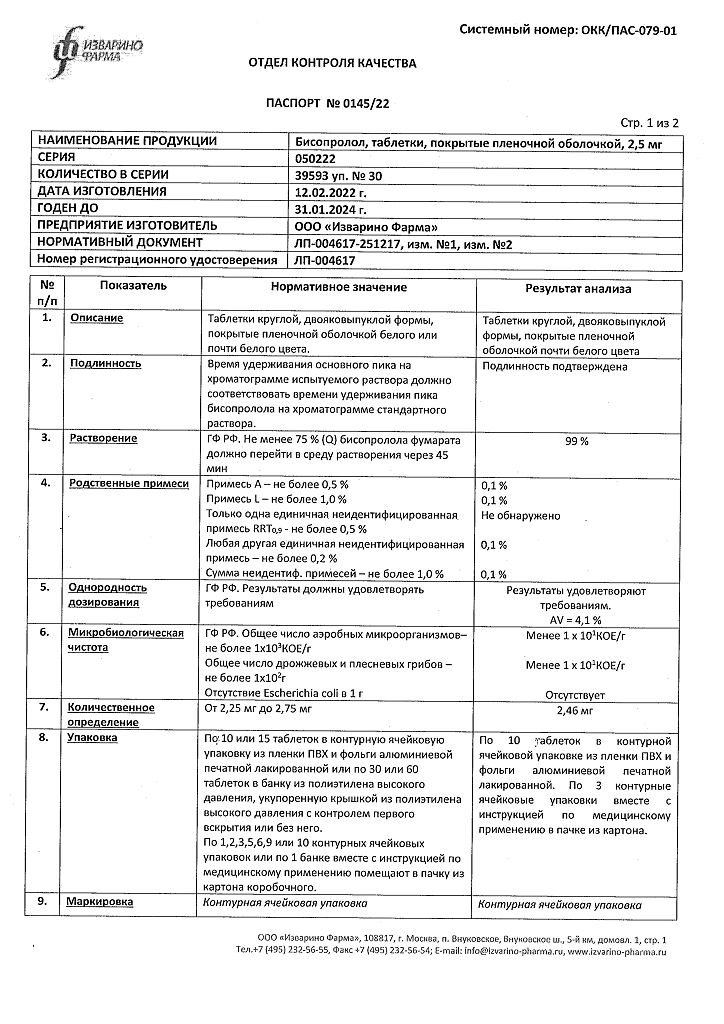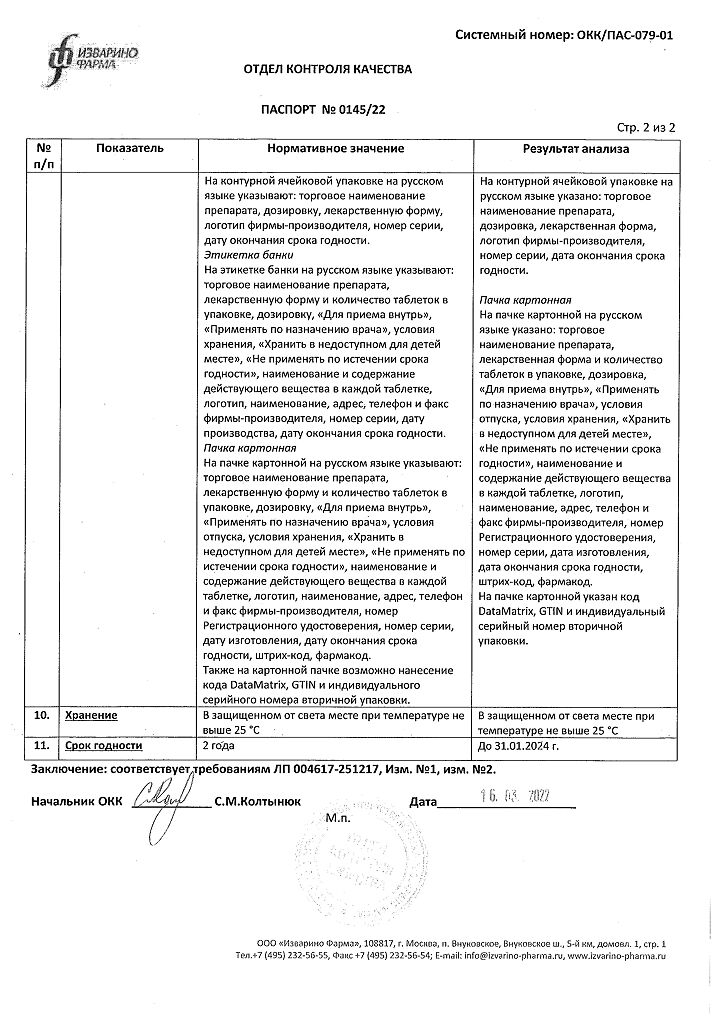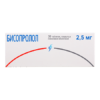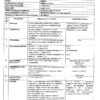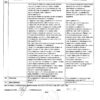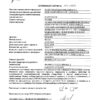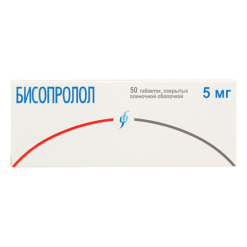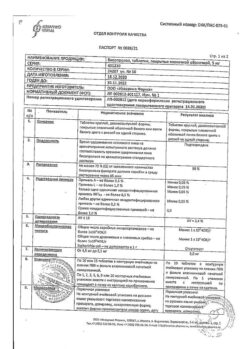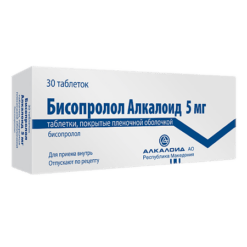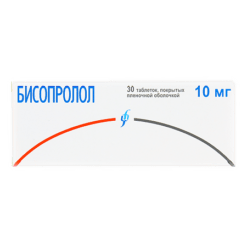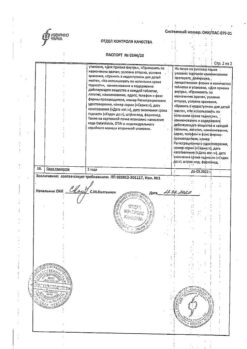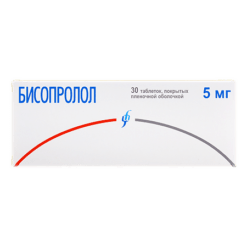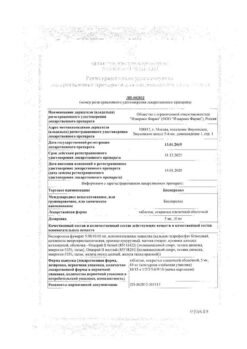No products in the cart.
Bisoprolol, 2,5mg 30 pcs.
€2.68 €2.44
Description
Pharmacotherapeutic group: beta1-adrenoblocker selective
ATC code: C07AB07 Pharmacological properties
Pharmacodynamics
A selective beta1-adrenoblocker, without intrinsic sympathomimetic activity, has no membrane-stabilizing action.
Limits blood plasma renin activity, reduces myocardial oxygen demand, reduces heart rate (HR) (at rest and under load). It has antihypertensive, antiarrhythmic and antianginal effects. By blocking at low doses of beta1-adrenoreceptors of the heart, reduces catecholamine-stimulated formation of cyclic adenosine monophosphate (cAMP) from adenosine triphosphate (ATP), reduces intracellular calcium ion current, has negative chrono-, dromo-, batmo- and inotropic effects (inhibits conduction and excitability, slows atrioventricular (AV) conduction).
If the therapeutic dose is exceeded, it has beta2-adrenoblocking effect.
The total peripheral vascular resistance at the beginning of the drug use during the first 24 h is slightly increased (as a result of reciprocal increase of activity of alpha-adrenoreceptors) which returns to baseline after 1-3 days and decreases with prolonged administration.
The antihypertensive effect is associated with reduction of the minute blood volume, sympathetic stimulation of peripheral vessels, reduction of renin-angiotensin-aldosterone system activity (of great importance for patients with initial renin hypersecretion), restoration of sensitivity in response to reduction of blood pressure (BP) and influence on the central nervous system (CNS). In arterial hypertension the effect occurs after
2-5 days, stable effect – after 1-2 months.
The antianginal action is caused by decrease of myocardial oxygen demand as the result of HR shortening, slight decrease of contractility, prolongation of diastole, improvement of myocardial perfusion.
The antiarrhythmic action is caused by the removal of arrhythmogenic factors (tachycardia, increased activity of the sympathetic nervous system, increased content of CAMF, arterial hypertension), the decrease of spontaneous excitation rate of sinus and ectopic pacemakers and AV conduction slowing (mainly in antegrade and to a lesser extent in retrograde direction via AV node) and by additional pathways.
When used at moderate therapeutic doses, unlike non-selective beta-adrenoblockers, it has less pronounced effects on organs containing beta2– adrenoreceptors (pancreas, skeletal muscles, smooth muscles of peripheral arteries, bronchi and uterus) and on carbohydrate metabolism, does not cause retention of sodium ions in the body. The severity of atherogenic action does not differ from that of propranolol.
Bisoprololol decreases heart rate, stroke volume, and consequently myocardial oxygen demand in patients with coronary heart disease (CHD) without evidence of chronic heart failure (CHF) when administered alone.
Pharmacokinetics
Intake
Bisoprolol is almost completely (> 90%) absorbed from the gastrointestinal tract. Its bioavailability due to insignificant metabolism “at primary passage” through the liver (approximately 10%) is about
90% after oral administration. Food intake has no effect on bioavailability. Bisoprolol exhibits linear kinetics, and its plasma concentrations are proportional to the dose taken in the dose range from 5 to 20 mg. Maximum plasma concentrations are reached after 2-3 hours.
Distribution
Bisoprolol is fairly widely distributed. The volume of distribution is
3.5 l/kg. The binding to plasma proteins reaches about 30%.
Metabolism
Metabolized by the oxidative pathway without subsequent conjugation. All metabolites are polar (water-soluble) and are excreted by the kidneys. The major metabolites found in plasma and urine have no pharmacological activity. The data obtained from in vitro experiments with human liver microsomes show that bisoprolol is metabolized primarily by the CYP3A4 isoenzyme (about
95%) and the CYP2D6 isoenzyme plays only a minor role.
The clearance of bisoprolol is determined by a balance between its excretion via the kidneys unchanged (about 50%) and its oxidation in the liver (about 50%) to metabolites, which are then also excreted by the kidneys. Total clearance is 15 l/h. The half-life (T1/2) is 10-12 h.
There are no data on the pharmacokinetics of bisoprolol in patients with CHF and concomitant hepatic or renal impairment.
Indications
Indications
Chronic heart failure.
Pharmacological effect
Pharmacological effect
Pharmacotherapeutic group: selective beta1-blocker
ATX code: C07АВ07
Pharmacological properties
Pharmacodynamics
A selective beta1-blocker, without its own sympathomimetic activity, does not have a membrane-stabilizing effect.
Reduces plasma renin activity, reduces myocardial oxygen demand, and reduces heart rate (heart rate) (at rest and during exercise). It has antihypertensive, antiarrhythmic and antianginal effects. By blocking beta1-adrenergic receptors of the heart in low doses, it reduces the catecholamine-stimulated formation of cyclic adenosine monophosphate (cAMP) from adenosine triphosphate (ATP), reduces the intracellular current of calcium ions, and has a negative chrono-, dromo-, bathmo- and inotropic effect (inhibits conductivity and excitability, slows down atrioventricular (AV) conduction).
When the therapeutic dose is exceeded, it has a beta2-adrenergic blocking effect.
The total peripheral vascular resistance at the beginning of drug use in the first 24 hours increases slightly (as a result of a reciprocal increase in the activity of alpha-adrenergic receptors), which returns to its original value after 1-3 days, and decreases with long-term administration.
The antihypertensive effect is associated with a decrease in minute blood volume, sympathetic stimulation of peripheral vessels, a decrease in the activity of the renin-angiotensin-aldosterone system (of great importance for patients with initial hypersecretion of renin), restoration of sensitivity in response to a decrease in blood pressure (BP) and an effect on the central nervous system (CNS). In case of arterial hypertension, the effect occurs through
2-5 days, stable effect – after 1-2 months.
The antianginal effect is due to a decrease in myocardial oxygen demand as a result of a decrease in heart rate, a slight decrease in contractility, prolongation of diastole, and improved myocardial perfusion.
The antiarrhythmic effect is due to the elimination of arrhythmogenic factors (tachycardia, increased activity of the sympathetic nervous system, increased cAMP content, arterial hypertension), a decrease in the rate of spontaneous excitation of sinus and ectopic pacemakers and a slowdown of AV conduction (mainly in the antegrade and to a lesser extent in the retrograde directions through the AV node) and along additional pathways.
When used in average therapeutic doses, in contrast to non-selective beta-blockers, it has a less pronounced effect on organs containing beta2-adrenergic receptors (pancreas, skeletal muscles, smooth muscles of peripheral arteries, bronchi and uterus) and on carbohydrate metabolism, does not cause sodium ion retention in the body. The severity of the atherogenic effect does not differ from the effect of propranolol.
When used once in patients with coronary heart disease (CHD) without signs of chronic heart failure (CHF), bisoprolol reduces heart rate, stroke volume and, as a result, reduces the ejection fraction and myocardial oxygen demand.
Pharmacokinetics
Suction
Bisoprolol is almost completely (> 90%) absorbed from the gastrointestinal tract. Its bioavailability due to its low first pass metabolism through the liver (approximately 10%) is approximately
90% after oral administration. Food intake does not affect bioavailability. Bisoprolol exhibits linear kinetics, with plasma concentrations being proportional to the dose administered over a dose range of 5 to 20 mg. The maximum concentration in blood plasma is achieved after 2-3 hours.
Distribution
Bisoprolol is distributed quite widely. The volume of distribution is
3.5 l/kg. The binding to plasma proteins reaches approximately 30%.
Metabolism
Metabolized via the oxidative pathway without subsequent conjugation. All metabolites are polar (water-soluble) and are excreted by the kidneys. The main metabolites found in blood plasma and urine do not exhibit pharmacological activity. Data obtained from in vitro experiments with human liver microsomes indicate that bisoprolol is metabolized primarily by the CYP3A4 isoenzyme (about
95%), and the CYP2D6 isoenzyme plays only a minor role.
Removal
The clearance of bisoprolol is determined by the balance between its excretion through the kidneys unchanged (about 50%) and oxidation in the liver (about 50%) to metabolites, which are then also excreted by the kidneys. The total clearance is 15 l/h. The half-life (T1/2) is 10-12 hours.
There are no data on the pharmacokinetics of bisoprolol in patients with CHF and concurrent impairment of liver or kidney function.
Special instructions
Special instructions
You should not abruptly interrupt treatment with bisoprolol or change the recommended dose without first consulting your doctor, as this may lead to a temporary deterioration in heart function. Treatment should not be interrupted suddenly, especially in patients with coronary artery disease. If discontinuation of treatment is necessary, the dose should be reduced gradually.
At the initial stages of treatment with bisoprolol, patients require constant monitoring.
The drug should be used with caution in the following cases:
– severe forms of COPD and non-severe forms of bronchial asthma;
– diabetes mellitus with significant fluctuations in blood glucose concentration: symptoms of a pronounced decrease in glucose concentration (hypoglycemia), such as tachycardia, palpitations or increased sweating, may be masked;
– strict diet;
– carrying out desensitizing therapy;
– AV blockade of the first degree;
– Prinzmetal’s angina;
– mild to moderate peripheral arterial circulatory disorders (increased symptoms may occur at the beginning of therapy);
– psoriasis (including history).
Respiratory system: for bronchial asthma or COPD, simultaneous use of bronchodilators is indicated. In patients with bronchial asthma, there may be an increase in airway resistance, which will require a higher dose of beta2-agonists. In patients with COPD, bisoprolol prescribed in combination therapy for the treatment of heart failure should be started at the lowest possible dose, and patients should be carefully monitored for the appearance of new symptoms (eg, shortness of breath, exercise intolerance, cough).
Allergic reactions: Beta blockers, including bisoprolol, may increase sensitivity to allergens and the severity of anaphylactic reactions due to the weakening of adrenergic compensatory regulation under the influence of beta blockers. Therapy with epinephrine (adrenaline) does not always give the expected therapeutic effect.
General anesthesia: When performing general anesthesia, the risk of beta-adrenergic blockade should be taken into account. If it is necessary to discontinue bisoprolol therapy before surgery, this should be done gradually and completed 48 hours before general anesthesia. The anesthesiologist should be warned about bisoprolol therapy.
Pheochromocytoma: in patients with an adrenal tumor (pheochromocytoma), bisoprolol can only be prescribed while using alpha-blockers.
Hyperthyroidism: when treated with bisoprolol, symptoms of hyperfunction (hyperthyroidism) of the thyroid gland may be masked.
Impact on the ability to drive vehicles and machinery
The drug Bisoprolol does not affect the ability to drive vehicles, according to the results of a study in patients with coronary artery disease. However, due to individual reactions, the ability to drive vehicles or operate technically complex mechanisms may be impaired. Particular attention should be paid to this at the beginning of therapy, after changing the dose, and also when consuming alcohol at the same time.
Active ingredient
Active ingredient
Bisoprolol
Composition
Composition
1 film-coated tablet contains:
Tablet core composition
Active ingredient: bisoprolol fumarate – 2.5 mg.
Excipients: anhydrous calcium hydrogen phosphate – 46.875 mg, microcrystalline cellulose – 18.5 mg, corn starch – 5.625 mg, magnesium stearate – 0.75 mg, colloidal silicon dioxide – 0.75 mg.
Tablet shell composition: opadry II white (85F18422) (polyvinyl alcohol – 40%, titanium dioxide – 25%, macrogol 3350 – 20.2%, talc – 14.8%) – 3.0 mg.
Pregnancy
Pregnancy
The use of the drug during pregnancy is possible only if the expected benefit to the mother outweighs the potential risk to the fetus.
Beta blockers reduce blood flow to the placenta and may affect fetal development. Blood flow in the placenta and uterus should be closely monitored, as well as the growth and development of the unborn child should be monitored, and alternative therapeutic measures should be taken if adverse events occur in relation to the pregnancy and/or fetus.
The newborn should be carefully examined after birth. In the first 3 days of life, symptoms of bradycardia and hypoglycemia may occur.
There are no data on the excretion of bisoprolol into breast milk or the safety of bisoprolol exposure in infants. If it is necessary to use the drug during breastfeeding, the issue of stopping breastfeeding should be decided.
Contraindications
Contraindications
– hypersensitivity to bisoprolol or to any of the excipients;
– acute heart failure, chronic heart failure in the stage of decompensation, requiring inotropic therapy;
– cardiogenic shock;
– atrioventricular (AV) block of II and III degrees (without a pacemaker);
– sinoatrial blockade;
– sick sinus syndrome;
– severe bradycardia (heart rate <60 beats/min);
– severe arterial hypotension (systolic blood pressure < 100 mm Hg);
– severe forms of bronchial asthma;
– severe peripheral arterial circulation disorders or Raynaud’s syndrome;
– metabolic acidosis;
– pheochromocytoma (without simultaneous use of alpha-blockers);
– children and adolescents under 18 years of age (efficacy and safety have not been established).
With caution
– carrying out desensitizing therapy;
– hyperthyroidism;
– type I diabetes mellitus and diabetes mellitus with significant fluctuations in blood glucose concentrations;
– severe renal failure (creatinine clearance (CC) less than
20 ml/min);
– severe liver dysfunction;
– psoriasis;
– AV blockade of the first degree;
– Prinzmetal’s angina;
– restrictive cardiomyopathy;
– congenital heart defects or heart valve disease with severe hemodynamic disturbances;
– chronic heart failure with myocardial infarction within the last 3 months;
– peripheral circulation disorders;
– severe forms of chronic obstructive pulmonary disease;
– bronchospasm (history);
– allergic reactions (history);
– general anesthesia;
– strict diet.
Side Effects
Side Effects
The frequency of the adverse reactions listed below was distributed as follows (WHO classification): very common (≥ 1/10), common (≥ 1/100, < 1/10), uncommon (≥ 1/1000, < 1/100), rare (≥ 1/10000, < 1/1000); very rare (<1/10000, including isolated reports).
From the cardiovascular system: very often – bradycardia; often – worsening symptoms of CHF, a feeling of coldness or numbness in the extremities, a pronounced decrease in blood pressure; uncommon – AV conduction disturbance, orthostatic hypotension.
From the nervous system: often – dizziness, headache; rarely – loss of consciousness.
Mental disorders: infrequently – depression, insomnia; rarely – hallucinations, nightmares.
From the senses: rarely – decreased tear production (should be taken into account when wearing contact lenses), hearing impairment; very rarely – conjunctivitis.
From the respiratory system: infrequently – bronchospasm in patients with bronchial asthma or a history of obstructive airway diseases; rarely – allergic rhinitis.
From the digestive system: often – nausea, vomiting, diarrhea, constipation; rarely – hepatitis.
From the musculoskeletal system: uncommon – muscle weakness, muscle cramps.
From the genitourinary system: rarely – impaired potency.
From the skin: rarely – hypersensitivity reactions, such as itching, skin rash, hyperemia of the skin; very rarely – alopecia; beta-blockers may worsen the symptoms of psoriasis or cause a psoriasis-like rash.
From the laboratory parameters: rarely – an increase in the concentration of triglycerides and the activity of “liver” transaminases in the blood (aspartate aminotransferase (AST), alanine aminotransferase (ALT)).
General disorders and disorders at the injection site: often – asthenia, increased fatigue.
Interaction
Interaction
The effectiveness and tolerability of bisoprolol may be affected by concomitant use of other medications. This interaction can also occur when two drugs are taken within a short period of time. The doctor must be informed about taking other medications, even if taken without a doctor’s prescription (i.e., over-the-counter drugs).
Combinations not recommended
Class I antiarrhythmic drugs (for example, quinidine, disopyramide, lidocaine, phenytoin, flecainide, propafenone), when used simultaneously with bisoprolol, can reduce AV conductivity and myocardial contractility.
Blockers of “slow” calcium channels (SCBC) such as verapamil and, to a lesser extent, diltiazem, when used simultaneously with bisoprolol, can lead to a decrease in myocardial contractility and impaired AV conduction. In particular, intravenous administration of verapamil to patients taking beta-blockers can lead to severe arterial hypotension and AV blockade.
Centrally acting antihypertensives (such as clonidine, methyldopa, moxonidine, rilmenidine) can lead to a decrease in heart rate and cardiac output, as well as vasodilation due to a decrease in central sympathetic tone. Abrupt withdrawal, especially before discontinuation of beta-blockers, may increase the risk of developing rebound hypertension.
Combinations requiring special caution
BMCC dihydropyridine derivatives (for example, nifedipine, felodipine, amlodipine) when used simultaneously with bisoprolol may increase the risk of arterial hypotension. In patients with CHF, the risk of subsequent deterioration in cardiac contractility cannot be excluded.
Class III antiarrhythmic drugs (eg, amiodarone) may worsen AV conduction disturbances.
The effect of beta-blockers for topical use (for example, eye drops for the treatment of glaucoma) may enhance the systemic effects of bisoprolol (lowering blood pressure, lowering heart rate).
Parasympathomimetics, when used simultaneously with bisoprolol, may increase AV conduction disturbances and increase the risk of bradycardia.
The hypoglycemic effect of insulin or oral hypoglycemic agents may be enhanced. Signs of hypoglycemia – in particular tachycardia – may be masked or suppressed. Such interactions are more likely when using non-selective beta-blockers.
General anesthesia agents may increase the risk of cardiodepressive effects, leading to arterial hypotension (see section “Special Instructions”).
Cardiac glycosides, when used simultaneously with bisoprolol, can lead to an increase in impulse conduction time, and thus to the development of bradycardia.
Nonsteroidal anti-inflammatory drugs (NSAIDs) may reduce the hypotensive effect of bisoprolol.
The simultaneous use of bisoprolol with beta-agonists (for example, isoprenaline, dobutamine) may lead to a decrease in the effect of both drugs.
The combination of bisoprolol with adrenergic agonists that affect beta and alpha adrenergic receptors (for example, norepinephrine (norepinephrine), epinephrine (adrenaline)) may enhance the vasoconstrictor effects of these drugs that occur with the participation of alpha adrenergic receptors, leading to an increase in blood pressure. Such interactions are more likely when using non-selective beta-blockers.
Antihypertensive drugs, as well as other drugs with a possible antihypertensive effect (for example, tricyclic antidepressants, barbiturates, phenothiazines), may enhance the hypotensive effect of bisoprolol.
Mefloquine, when used simultaneously with bisoprolol, may increase the risk of bradycardia.
MAO inhibitors (except MAO B inhibitors) may enhance the hypotensive effect of beta-blockers. Concomitant use may also lead to the development of a hypertensive crisis.
Overdose
Overdose
Symptoms: severe bradycardia, AV block, marked decrease in blood pressure, acute heart failure, hypoglycemia, bronchospasm.
Sensitivity to a single high dose of bisoprolol varies widely among individual patients and patients with CHF are likely to be highly sensitive.
Treatment: first of all, you need to stop taking the drug and start supportive symptomatic therapy. For severe bradycardia, intravenous atropine is administered. If the effect is insufficient, a drug with a positive chronotropic effect can be administered with caution. Sometimes temporary placement of an artificial pacemaker may be necessary.
With a pronounced decrease in blood pressure, intravenous administration of plasma-substituting solutions and vasopressor drugs is recommended.
For hypoglycemia, intravenous administration of dextrose (glucose) and glucagon may be indicated.
For AV blockade, patients should be closely monitored and treated with beta-agonists such as epinephrine (adrenaline). If necessary, install an artificial pacemaker.
In case of exacerbation of CHF, intravenous administration of diuretics, drugs with a positive inotropic effect, as well as vasodilators.
For bronchospasm, prescribe bronchodilators, including beta2-adrenergic agonists and/or aminophylline.
Storage conditions
Storage conditions
In a place protected from light at a temperature not exceeding 25 ° C.
Keep out of the reach of children.
Shelf life
Shelf life
2 years.
Do not use after expiration date.
Manufacturer
Manufacturer
Izvarino Pharma, Russia
Additional information
| Shelf life | 2 years. Do not use after the expiration date. |
|---|---|
| Conditions of storage | In the dark place at a temperature not exceeding 25 °С. Contain out of reach of children. |
| Manufacturer | Izvarino Pharma, Russia |
| Medication form | pills |
| Brand | Izvarino Pharma |
Other forms…
Related products
Buy Bisoprolol, 2,5mg 30 pcs. with delivery to USA, UK, Europe and over 120 other countries.


